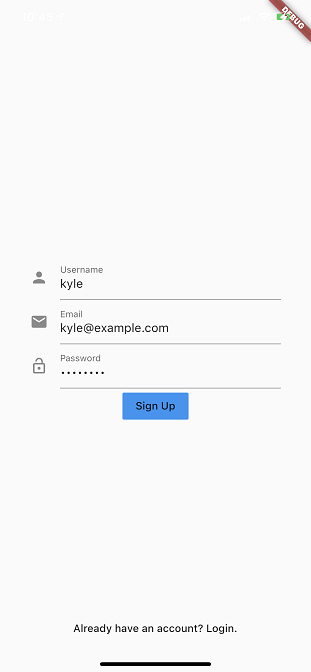Creating a SignUp Widget
Create a SignUp widget
The user will need to be able to sign up before they can sign in. Let’s implement the SignUpPage in a new file sign_up_page.dart
import 'package:flutter/material.dart';
class SignUpPage extends StatefulWidget {
@override
State<StatefulWidget> createState() => _SignUpPageState();
}
class _SignUpPageState extends State<SignUpPage> {
final _usernameController = TextEditingController();
final _emailController = TextEditingController();
final _passwordController = TextEditingController();
@override
Widget build(BuildContext context) {
return Scaffold(
body: SafeArea(
minimum: EdgeInsets.symmetric(horizontal: 40),
child: Stack(children: [
// Sign Up Form
_signUpForm(),
// Login Button
Container(
alignment: Alignment.bottomCenter,
child: FlatButton(
onPressed: () {},
child: Text('Already have an account? Login.')),
)
])),
);
}
Widget _signUpForm() {
return Column(
mainAxisAlignment: MainAxisAlignment.center,
children: [
// Username TextField
TextField(
controller: _usernameController,
decoration:
InputDecoration(icon: Icon(Icons.person), labelText: 'Username'),
),
// Email TextField
TextField(
controller: _emailController,
decoration:
InputDecoration(icon: Icon(Icons.mail), labelText: 'Email'),
),
// Password TextField
TextField(
controller: _passwordController,
decoration: InputDecoration(
icon: Icon(Icons.lock_open), labelText: 'Password'),
obscureText: true,
keyboardType: TextInputType.visiblePassword,
),
// Sign Up Button
FlatButton(
onPressed: _signUp,
child: Text('Sign Up'),
color: Theme.of(context).accentColor)
],
);
}
void _signUp() {
final username = _usernameController.text.trim();
final email = _emailController.text.trim();
final password = _passwordController.text.trim();
print('username: $username');
print('email: $email');
print('password: $password');
}
}
Our SignUpPage is almost identical to the LoginPage with the exception that it has an additional field for email and the text for the buttons have been changed.
Let’s add the SignUpPage as a MaterialPage in the Navigator of main.dart too.
... // home: Navigator( (line 20)
pages: [
MaterialPage(child: LoginPage()),
MaterialPage(child: SignUpPage())
],
... // onPopPage: (route, result) => route.didPop(result),
You’ll see that there’s no definition in scope for LoginPage() and SingupPage(). We’ll need to import those classes into scope for main.dart.

Let’s add that import now to main.dart
... // import 'login_page.dart'; (line 2)
import 'sign_up_page.dart';
We also need to make a configuration update for Android, update minSdkVersion to 21 ./android/app/build.gradle
... // applicationId "com.example.workshop_app" (line 37)
minSdkVersion 21
... // targetSdkVersion 29
Now run the app, this will usually take a few minutes to launch.
